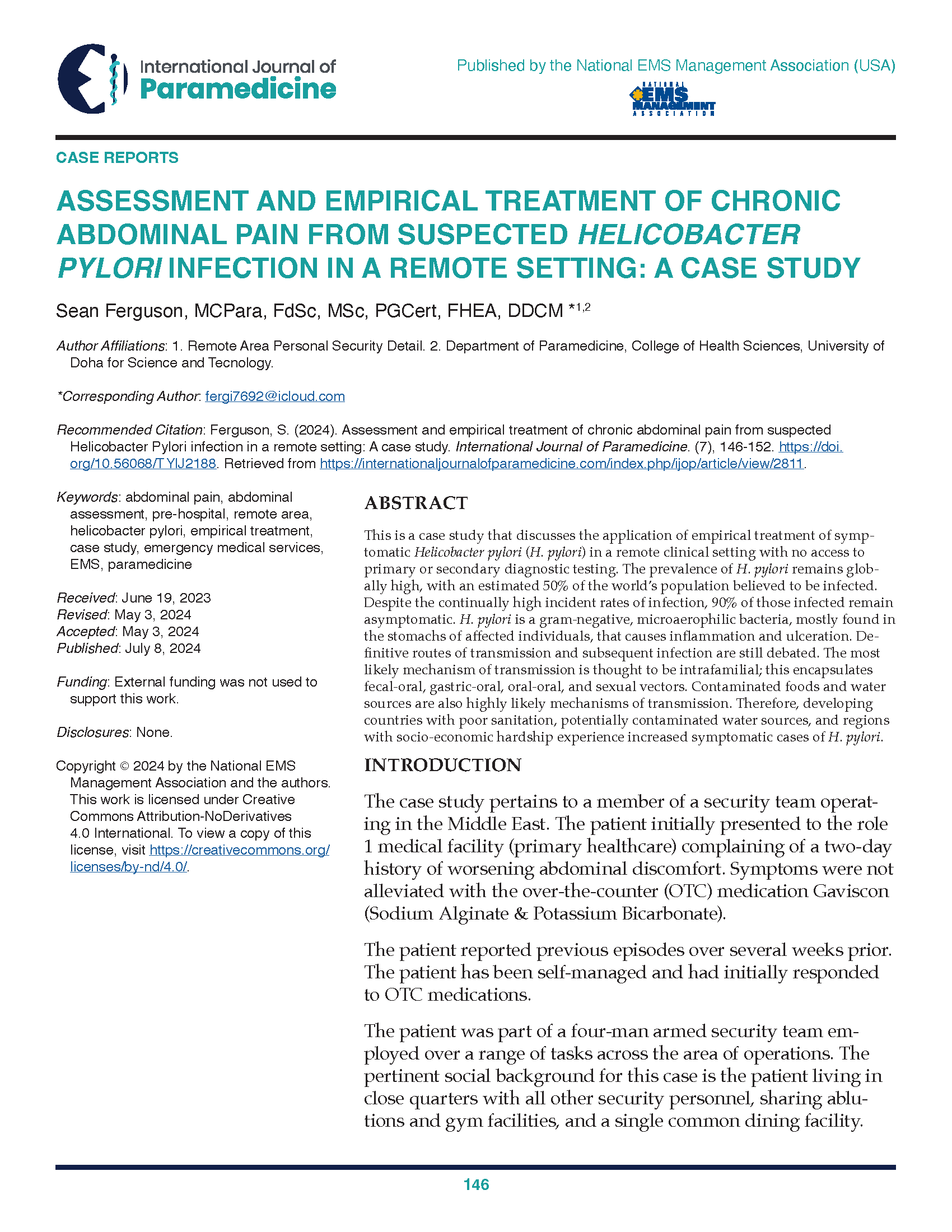Assessment and Empirical Treatment of Chronic Abdominal Pain from Suspected Helicobacter Pylori Infection In a Remote Setting A Case Study
Main Article Content
Abstract
The prevalence of Helicobacter Pylori (H. Pylori) remains globally high, with an estimated 50% of the words population believed to be infected. Despite the continually high incident rates of infection 90% of those infected remain asymptomatic. H.Pylori is a gram-negative, microaerophilic bacteria, mostly found in stomach of affected individuals that causes inflammation and ulceration.
Definitive routes of transmission and subsequent infection are still debated. The most likely mechanism of transmission is thought to be intrafamilliar, this encapsulates fecal-oral, gastric-oral, oral-oral and sexual vectors. Contaminated foods and water sources are also highly likely mechanisms of transmission. Therefore in developing countries with poor sanitation, potentially contaminated water sources and regions with social-economic hardship experience increased symptomatic cases of H.Pylori.
Article Details

This work is licensed under a Creative Commons Attribution-NoDerivatives 4.0 International License.
Publishing in IJOP allows authors to keep their copyright while giving IJOP unrestricted copyright permissions. Articles published in IJOP use Creative Common Attribution 4.0 International (CC BY-ND 4.0) licensing. This license requires that re-users give credit to the creator. It allows re-users to copy and distribute the material in any medium or format in unadapted form only, even for commercial purposes. Additional terms apply and can be accessed here.
Publishing in IJOP also allows authors to have contracts for non-exclusive distribution of the Journal's published version of the article, such as posting to an institutional repository or publication in a book, on the condition that the original publication in the original layout format in IJOP is retained and acknowledged.
We permit and encourage authors to post the articles they published in IJOP on their affiliated websites. This helps share the information, encourages citation in other works, and promotes scholarly discourse in the spirit of open access.
References
Aziz, R. K., Khalifa, M. M., & Sharaf, R. R. (2015). Contaminated water as a source of Helicobacter pylori infection: A review. Journal of Advanced Research, 6(1), 539-547. [Online]. Available at: http://dx.doi.org/10.1016/j.jare.2013.07.007 [Accessed 5 June 2023].
Hooi, J. K. Y., Lai, W. Y., Ng, W. K., Suen, M. M. Y., & Underwood, F. E. (2017). Global Prevalence of Helicobacter Pylori Infection: Systematic review and Meta-Analysis. Gastroenterology. Epub 2017 Apr 27, 153(2). [Online]. Available at: https://doi.org/10.1053/j.gastro.2017.04.022 [Accessed 10 June 2023].
Larsson, G., Hansson, P., Olsson, E., Herlitz, J., & Hagiwara, M. (2022). Prehospital assessment of patients with abdominal pain triaged to self-care at home: an observational study. BMC Emergency Medicine, 22(92), 1-9. [Online]. Available at: https://doi/org/10.1186/s12873-022-00649-x [Accessed 5 June 2023].
Malfertheiner, P., Megraud, F., O'Morain, C., Bazzoli, F., El-Omar, E., Graham, D., & Hunt, R. (2007). Current concepts in the management of Helicobacter pylori infection: the Maastricht III Consensus Report. PubMed, 56(6). [Online]. Available at: https://doi.org/10.1136/gut.2006.101634 [Accessed 6 June 2023].
Mansour, M. B. (2021). Clinical Case Report: Failure of 3 regimens to treat a case of Gastritis caused by Helicobacter pylori in a 42-year-old. Journal of Pharmacy and Pharmaceutical Research, 5(1), 1-2.
National Institute for Health and Care Excellence. (2014). Dyspepsia and gastro-oesophageal reflux disease: investigation and management of. Clinical guideline update. UK: NICE. pp. 7-25.
Osterwalder, I., Özkan, M., Malinovska, A., & Nickel, C. H. (2020). Acute Abdominal Pain: Missed Diagnoses, Extra-Abdominal Conditions, and Outcomes. Journal of Clinical Medicine, 9(4), 899. [Online]. Available at: https://doi.org/10.3390/jcm9040899 [Accessed 8 June 2023].
Sharp, M.-L., Fear, N. T., Rona, R. J., Wessely, S., & Greenber, N. Stigma as a barrier to seeking healthcare among military personnel with mental health problems. Epidemiology Reviews, 37(1), 144-162. [Online]. Available at: https://doi.org/10.1093/epirev/mxu012 [Accessed 6 June 2023].

